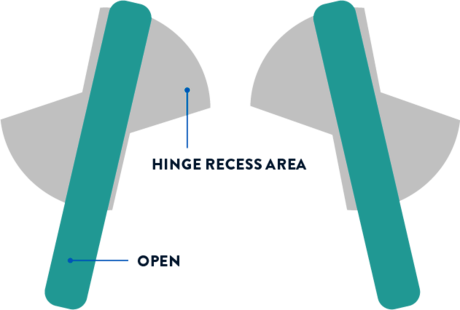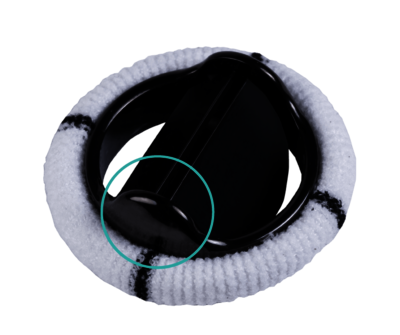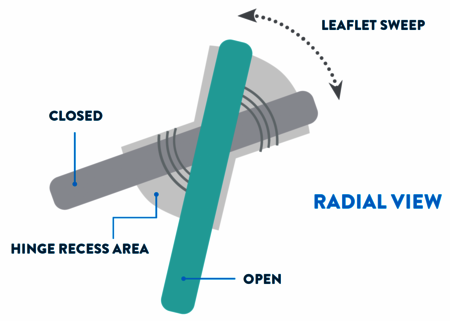Unique design features have established Abbott mechanical heart valves—including the Regent™ and Masters Series—as a gold standard for reliability and performance, while maintaining low complication rates over the long term.
CONFIDENTLY IMPLANT THE MOST TRUSTED AORTIC MECHANICAL VALVES IN THE WORLD


Abbott mechanical heart valves lead the way with a proven bileaflet design that results in low thrombogenicity and excellent patient outcomes.
- Leaflets open to an 85-degree angle in systole due to their upstream positioning, enabled by unique pivot guards (shown at right)
- Strong, uniform velocities within hinge recesses aid washout of blood elements3
- Low carbon surface area means less thrombus formation
- Orifice-to-annulus ratio (as high as 84%) ensures large effective orifice areas (EOAs) and reduces prosthesis-patient mismatch4

THE PIVOT GUARD DESIGN | AN ABBOTT HALLMARK
Featured in all Abbott Mechanical Heart Valves, the Pivot Guard offers benefits both during implant and post-implant
- Recessed design minimizes interaction with sub-annular native mitral valve apparatus
- Minimized carbon surface area can lessen thrombus formation
- Pivot guards help shield pivot mechanism from pannus in growth
- Enables a consistent 85-degree opening angle, promoting minimized leaflet flutter and more laminar flow through the orifice5

LOW THROMBOGENICITY | A NECESSITY IN MHV REPLACEMENTS
Designed with Low Thrombogenicity at the Forefront
- Large internal diameters up to 26.1 mm available promote low pressure gradients6
- Low gradients can help minimize shear stress and thrombogenicity7
- Uniform velocities within hinge recesses help aid washout of blood elements3
- Abbott hinge design enables complete leaflet sweep, further aiding washout
- Abbott hinge design enables complete leaflet sweep, further aiding washout

TV
TV
- Internal Sales Tracking Spreadsheet. Data on file at Abbott.
- MHV Paper List. Data on file at Abbott.
- Jun BH, Saikrishnan N, Yoganathan AP. Micro particle image velocimetry measurements of steady diastolic leakage flow in the hinge of a St. Jude Medical Regent™ mechanical heart valve. Ann Biomed Eng. 2014;42(3):526-540. Published online 2013 Oct 2.doi: 10.1007/s10439-013- 0919-y
- Pibarot P, Dumesnil JG. Hemodynamic and clinical impact of prosthesis-patient mismatch in the aortic valve position and its prevention. J Am Coll Cardiol. 2000;36(4):1131-1141. doi.org/10.1016/s0735-1097(00)00859-7
- Shipkowitz T, Ambrus J, Kurk J, et al. Evaluation technique for bileaflet mechanical valves. J Heart Valve Dis. 2002;11(2):275-282.
- Internal Design Prints. Data on file at Abbott.
- Alemu Y, Bluestein D. Flow induced platelet activation and damage accumulation in a mechanical heart valve: numerical studies. Artif Organs. 2007;31(9):677-688. doi: 10.1111/j.1525-1594.2007.00446.x.
- Gammie JS, Chikwe J, Badhwar V, et al. Isolated mitral valve surgery: The Society of Thoracic Surgeons Adult Cardiac Surgery Database analysis. Ann Thorac Surg. 2018;106(3):716-727.
- Satter Y, Rauf H, Bareeqa S, et al. Transcatheter aortic valve replacement versus surgical aortic valve replacement: A review of aortic stenosis management. Cureus. 2019;11(12):e6431. doi: 10.7759/cureus.6431
- Nishimura RA. 2017 AHA/ACC focused update of the 2014 AHA/ACC guideline for the management of patients with valvular heart disease: A report of the American College of Cardiology/American Heart Association Task Force on Clinical Practice Guidelines. Circulation. 2017;136(9):1-123.
- Ren X. Aortic stenosis. Medscape. emedicine.medscape.com/article/150638-overview. Updated May 7, 2019.
- Dziadzko V, Clavel MA, Dziadzko M, et al. Outcome and undertreatment of mitral regurgitation: A community cohort study. Lancet. 2018;391(10124): 960-969.
- Regent Instructions for Use.
- Regent PMA Supplement.
- Okamura H, Yamaguchi A, Morita H, et al. Is the threshold for postoperative prosthesis-patient mismatch the same for all prostheses? Surg Today. 2013;43:871-876.
- Masters Series Instructions for Use.
- Baumgartner H, et al. 2017 ESC/EACTS Guidelines for the management of valvular heart disease: The Task Force for the Management of Valvular Heart Disease of the European Society of Cardiology (ESC) and the European Association for Cardio-Thoracic Surgery (EACTS). Eur Heart J. 2017;38(21):2739-2791.







